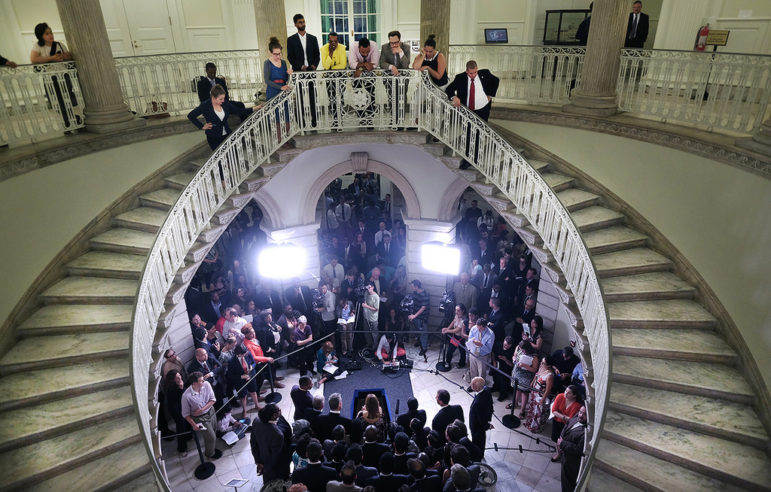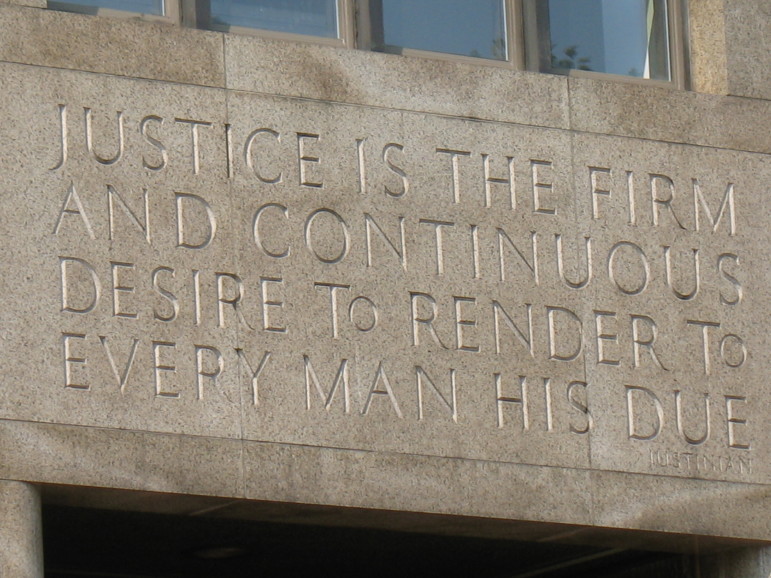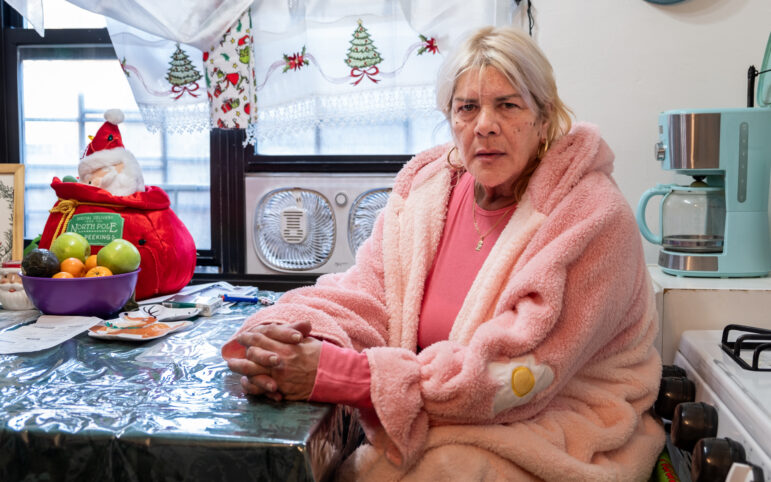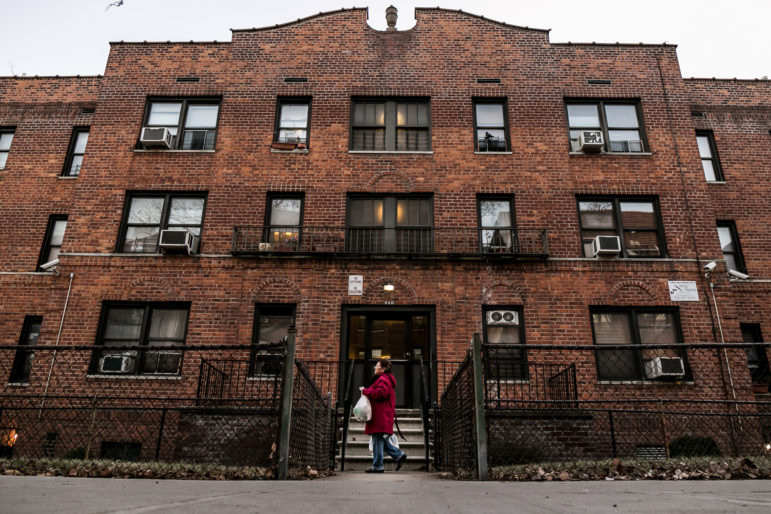
William Alatriste/City Council
Mayor de Blasio and Speaker Mark-Viverito meet in the City Hall rotunda to announce the fiscal 2015 budget agreement. Nonprofit contractors hope this year's budget provides more funding to cover the cost of the services they provide.
As New York City’s fiscal 2018 budget takes shape, voices from the city’s human-services sector have begun to cry out for help with a looming funding crisis that could leave many non-profit organizations scrambling to finance the services that serve needy New Yorkers.
There are 200,000 people in New York who work in the human services industry in the city, dealing with everything from elder care to youth employment and from domestic violence to housing needs.
But cuts in federal funding and tight-fisted city and state contracts could jeopardize the ability of organizations to provide future services to those vulnerable New Yorkers, industry figures say, with many describing a sector on the verge of crisis.
“It has been a quiet crisis that I think can no longer be quiet,” says Doug Bauer, executive director of The Clark Foundation, an organization that helps lift people out of poverty and recently sponsored an open forum on the human-services crisis. “The non-profit human services agencies that manage the social safety net in this city have really been systematically starved financially by the city and the state.”
At the forum, Bauer described an episode involving a long-time grantee who was owed $44 million by the city for services that were rendered more than a year ago. After a face-to-face meeting with “a fairly influential person at City Hall,”Bauer says, the issue was resolved and the debt was squared. But the effort and time involved took its toll on the organization—and it was one of the lucky ones. It’s the kind of nuts-and-bolts problem that might not trigger nationwide protests but poses a real, local challenge to a critical sector.
“We can worry about what’s going on in D.C. and we’re going have big advocacy battles about domestic spending in this country, and we should,” continues Bauer. “But at the end of the day, this issue sits ultimately at City Hall. They have got to figure this out.”
Key partners
Most of New York City’s array of social services are provided not directly by the government but by nonprofits who apply for and win contracts offered by agencies like the Department for the Aging and the Department of Youth and Community Development. The city spent a total of $15.3 billion in contracts during the 2016 fiscal year.
According to advocates, the crisis facing nonprofits is visible to City Hall. The Mayor’s Office of Contract Services responds to about 10,000 requests for assistance from non-profit organizations each year. Of those organizations, 18 percent are insolvent, 50 percent are facing deficits and cash flow issues, and while their clients are “living paycheck to paycheck, the employees are living payroll to payroll,” according to Allison Sesso, executive director of the Human Services Council of New York.
Sesso, whose organization puts out an annual report on the state of the human services sector throughout New York State, described the relationship between the city and the sector as a marriage that never separates out of necessity, as the city is mandated to provide human services while the organizations have no choice but to accept whatever funding they can.
The problems, nonprofits and their allies say, fall into two broad categories. One concerns the structure of city contracts—how they size up the cost of services at any point in time, as well as the natural increase in cost over the life of a contract. The other concerns apply to how the city manages its contracts and payments, and the difficulties and delays a nonprofit can encounter in getting the money it is owed.
Advocacy for assistance to the human services sector has been growing since as early the 1990s, when groups like the Human Services Council, a network of non-profit human services advocates, began to emerge. But real concern came around March 2015, when the Federation Employment and Guidance Services, a $250 million non-profit human services provider, closed its doors. It was a clear signal to the industry that there real threats at hand.
Frederick Shack, chief executive officer of Urban Pathways, a low-income housing non-profit organization, describes the partnership between nonprofits and the city or state as the only relationship the government has where they pay 85 to 87 cents on the dollar for services they purchase. In other words, the assumption is that nonprofits have other funds to support the work they do for the city.
Urban Pathways operates six outreach programs across the city, including one in Newark, New Jersey. Most public funding comes directly from the city’s Department of Homeless Services, Department of Health and Mental Hygiene and the New York State Department of Mental Health.
“If they are building a bridge, they pay 100 percent plus profit and if they are building buildings they pay 100 percent plus profit,” says Shack. “But with us, it’s that 87 cents to the dollar and they expect us to find ways to go out and bridge the gap.”
Shack, whose work includes leasing apartments for clients, gave a common example. The average New York City studio apartment is now about $1300 and the city contracts will allot about $895. To cover the difference, Urban Pathways might have to combine two units and have two people share one apartment.
According to Urban Pathway’s 2015 annual report, the organization’s total public funding and revenue amounted to $21,322,406. After footing the annual bill for program services and management expenses, their total expenses landed at $22,147,747. To make up the difference, organizations typically rely on donations from philanthropists and the public as they struggle to cover operating costs and staff wages.
Another issue with city contracts is they do not necessarily account for rising costs. A contract could have a flat rate over the course of five or more years, ignoring the rising prices of rent, utilities, maintenance, supplies and other operating needs.
Smaller non-profit organizations, like Womankind, which works with survivors of gender-based violence, face issues like paying out-of-pocket for large expenses in their IT department, as the funding from city contracts just doesn’t cover the breadth of service needs. Nonprofits might apply for funding to cover these costs but be denied because they are not deemed “direct services.”
Womankind’s director, Larry Lee, says he has been struggling to pay his staff overtime and is worried about the effects of the scheduled minimum wage increase in New York State.
City Hall responds
The mayor’s office has been working to strengthen the relationship between the city and sector, by creating the Nonprofit Resiliency Committee, which was launched by de Blasio this past September. The committee, which works alongside non-profit partners, aims to identify, design, and launch solutions to issues the sector faces in regard to administrative processes, program design and organizational infrastructure.
City Hall spokeswoman Freddie Goldstein told City Limits that the mayor’s office has been consistent supporters of the human services sector, noting the $15.6 billion average of contract awards for the past three years, the majority of which goes to non-profit organizations.
Nonprofit sector leaders and allies aren’t satisfied, but some argue the sector itself bears some responsibility for not clearly articulating its needs.
“Let’s not forget that this was a mayor who campaigned on achieving more equity for the most troubled in New York, and we allowed him to define what equity is,” says Jennifer Jones Austin, CEO of the Federation of Protestant Welfare Agencies. “We as a sector didn’t stand up and say this, this, and that. We did the work, they just didn’t pick it up,” referring to the cities lack of financial attention to other services of the sector besides homelessness.
At a recent forum organized by the Center for an Urban Future, City Councilwomen and chair of the Finance Committee Julissa Ferreras-Copeland said she sympathized with nonprofits but felt they needed to be more specific in justifying bigger city spending to meet their needs.
“This is something that the Council is very sensitive to, very aware of, and a priority. This is very real and valid to us,” said Ferreras-Copeland. “The Council can’t take on $500 million and say ‘Here you go,’ and even if we did, you shouldn’t be happy with that because then you’ll have to come again next year and do the same thing. We want to get this clear and resolved now and on a path to the future.”
In some cases, the administration’s legitimate desire for due diligence runs into a lack of capacity in nonprofits. For instance, City Hall stresses the importance of data, which can be a difficult task for those in the human-services industry to generate.
“Frankly, we go in with anecdotes, but the city is not going to give billions of dollars in funding to the non-profit, no matter how hard we try, based on anecdotal information. They want to see the hard numbers,” says Austin.
Finances aside, the process of certifying contracts between the city and organizations is also an issue. With the Council, city agencies, the mayor’s contracts office and the city comptroller all potentially involved, there is the potential for cascading delays.
The system sometimes results in nonprofits performing services months before they receive the money meant to pay for them, advocates say. On one occasion, Womankind was audited before they even received funds from their city contract.
“We have very major cash-flow problems. We’ve had contracts that don’t get registered in over a year. We’ve had audits before they even got us the money. So in fact, they’re auditing our own money. That’s death,” Lee says. “In a lot of ways they’re saying ‘too little, too late,’ or a ‘dollar short and a day too late’; and that really fits with what’s going on with the government.”
Late payments from the city can cause financial damage to the services provider, requiring them to take on debt or draw down on a line of credit, triggering fees.
The human-services sector is hoping to change the structure of how contract programs are designed and how the process is structured.
Changes sought
The backdrop to the local debate is the budget cuts likely to come from the Trump administration, which is likely to affect—if they haven’t already—summer youth employment, workforce development, adult protective services and more.
While both the federal and local problems pose an existential threat to some human services nonprofits, there is a clear difference between the leaders in those spheres. President Trump is not disposed to care much about nonprofits or they work they do. But Mayor de Blasio, a progressive dedicated to achieving broader social justice, does. So, advocates say, it’s a matter of elevating their case—and making more noise about their quiet crisis.
“People who come to do this work, come not because they are looking for a big payout, but out of a desire to serve those most vulnerable in New York City,” says Austin. “Sometimes that vulnerability is taken advantage of. You have people in city government, good intentions or not, who have a variety of competing concerns. So at the end of the day, it’s about who is going kick and scream and cry the loudest.”









One thought on “NYC’s Human-Service Providers Press for Changes in City Funding”
Great piece. Thanks very much.
Ray Horton